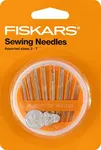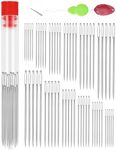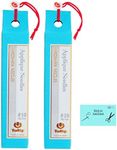Buying Guide for the Best Hand Sewing Needles
Choosing the right hand-sewing needle can make a significant difference in your sewing experience and the quality of your finished project. The right needle will depend on the type of fabric you are using, the kind of thread, and the specific sewing task you are undertaking. Here are some key specifications to consider when selecting hand-sewing needles and how to navigate them to find the best fit for your needs.Needle SizeNeedle size refers to the thickness and length of the needle. It is important because different fabrics and threads require different needle sizes to ensure smooth sewing and to avoid damaging the fabric. Needle sizes are usually indicated by a number; the higher the number, the finer and shorter the needle. For example, sizes 1-5 are thicker and longer, suitable for heavier fabrics like denim, while sizes 9-12 are finer and shorter, ideal for delicate fabrics like silk. Choose a needle size based on the weight and weave of your fabric: thicker needles for heavier fabrics and finer needles for lighter fabrics.
Needle TypeNeedle type refers to the specific design and purpose of the needle. This is important because different sewing tasks require different needle types to achieve the best results. Common types include sharps (general-purpose needles for most fabrics), betweens (shorter needles for quilting), embroidery needles (with larger eyes for thicker threads), and beading needles (very fine and long for threading beads). Consider the specific sewing task you are undertaking and choose a needle type that matches the requirements of that task.
Needle EyeThe needle eye is the hole through which the thread passes. The size and shape of the needle eye are important because they need to accommodate the thickness of the thread you are using without causing friction or breakage. Larger eyes are suitable for thicker threads, while smaller eyes are better for finer threads. When selecting a needle, ensure that the eye is large enough to easily thread your chosen thread but not so large that it weakens the needle or causes it to snag the fabric.
Needle PointThe needle point refers to the tip of the needle and its shape. This is important because different fabrics and sewing techniques require different needle points to penetrate the fabric effectively without causing damage. Common needle points include sharp points (for woven fabrics), ball points (for knits and stretch fabrics), and wedge points (for leather and vinyl). Choose a needle point based on the type of fabric you are working with: sharp points for tightly woven fabrics, ball points for stretchy fabrics, and wedge points for tough, non-woven materials.
MaterialNeedles can be made from various materials, including steel, nickel-plated steel, and gold-plated steel. The material is important because it affects the needle's durability, resistance to rust, and smoothness. Steel needles are strong and durable, nickel-plated needles offer extra smoothness and rust resistance, and gold-plated needles are ideal for those with metal allergies and provide a very smooth sewing experience. Consider the longevity and specific needs of your sewing projects when choosing the material of your needles.






















